How does Asperger’s (ASD) affect the experience of archaeological heritage?
I am Professor of Archaeology at the University of Chester. My eldest daughter – Jemimah – was diagnosed with Autism Spectrum Disorder (encompassing what is generally known as Asperger Syndrome) aged 5. Now aged 7, she loves exploring Britain’s heritage as much as I do.
I am not qualified to talk about this condition in general terms so please, dear reader, be sympathetic if I haven’t quite framed and explained the condition’s symptoms adequately as they relate to J or others. However, I do feel that many museums, heritage sites and ancient monuments take little account of children (and adults come to that) like J with these kinds of ‘hidden’ condition. Certainly, I haven’t seen any discussion of this issue in academic circles (but see links below). Moreover, I haven’t seen any discussion of how mortuary archaeology’s public dimensions relate to kids with Asperger and I would value any opinions on this.
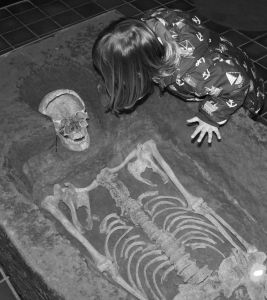
For this entry, my aim is to discuss and reflect on how, since I have known her over the last 7 years, her condition and her personality have created specific challenges relating to, and different experiences of, archaeological heritage. Notably, this includes sites connected with death, burial and commemoration which often transcend ‘heritage sites’ to encapsulate public spaces like churches, churchyards, cemeteries and war memorials. Consequently, I have learned to appreciate archaeological heritage differently, and critique heritage conservation, management and interpretation afresh.
I have also learned to be robust but flexible in my dealings with both J herself, but also staff and the public, to ensure her safety but also to ensure she is not overexposed to derogatory and negative behaviours of others. This is because, while she may lack certain perceptible social skills, make unexpected and loud behaviours and respond with distress to things that are intended to excite and interest kids, she is certainly aware of how people around her are treating her and she is very sensitive to the emotions and comments of others.
J and Heritage
As you might imagine, I visit many ancient monuments and heritage sites with J, including numerous with mortuary dimensions. Things are constantly changing and there is no static picture, as she learns to negotiate her environment and many different places and spaces. Things that she didn’t appreciate a year ago, she now does. Likewise, things she feared last year, are no longer a problem.
What is fascinating is to witness how she engages with, responds to, and remembers, archaeological heritage very differently from me and others I visit sites, monuments and landscapes with. I don’t take her to sites with specific educational aims and objectives, and I really don’t worry too much whether she becomes fascinated with ‘the past’ as such as she grows up , but I see her engagement with the outdoors, with other people and with domestic and wild animals and plants, with material culture, architecture and landscape, as all beneficial to her in a variety of ways. I want her to appreciate the past, appreciate the environment and also gain an appreciation of history, time, death and memory.
Is she gaining these? I honestly don’t know in detail, since there are so many delays in which she processes and can articulate. What I can say is that J has a terrific sense of humour, a keen eye for details others miss, a different perspective on her environment and most significantly of all, she has a phenomenal memory. Therefore, her social skills and ability to show gratitude or knowledge for a particular site or landscape visit means nothing; she can recount with enthusiasm details of the site and what we saw and did days, weeks, months, even years, later.
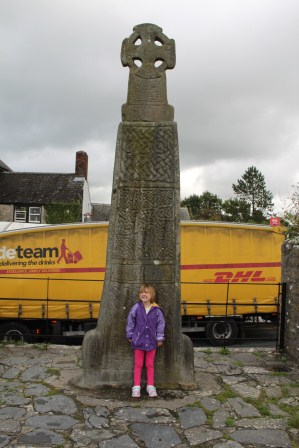
3 J Constants
To be honest, some days I personally dread taking J anywhere, anticipating or fearing her response to places and people. Other days she is a joy.
The first constant is that J is never predictable. What she will like and enjoy can be unexpected – like the herring gulls at Conwy Castle or a pulpit in a particular church – and likewise what causes her distress and upset can be completely unexpected, or at least unpredictable.
The second constant is that J’s experience and anxieties are never my sole concern: I always have to balance her needs against the other kids I’m with, who are younger than her, as well as my own interests in a site or monument, plus a due attentiveness to how we are collectively affecting the experiences of others. Hence, J gets only a fraction of my attention and consideration during heritage visits and I am careful to ensure her particular needs do not dominate any trip. This may seem uncaring, but my point is that while I am attentive to Jemimah’s personality and her distinctive needs, I refuse to let them dominate or predict what we (as a family) will and will not do. For example, when I recently visited Stokesay Castle with 2 other kids aged 4 and 6, she decided to run off because the moat was too muddy in her view (it was completely dry). I couldn’t race after her because I needed to stay with the younger ones. She was in a safe place and couldn’t run anywhere that could cause her harm (already being at the lowest point in the castle). I simply had to rely on another visitor to walk with her back to me where I waited at the moat exist. He had found her crying in distress only a few dozen metres out of my sight because I had ‘left her behind’. That particular guy was great, he didn’t judge her or judge me, he simply helped out by walking with her 30m until he found me waiting by the only way she could have left the moat by.
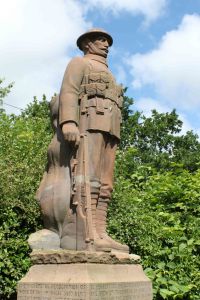
The third constant is that I never stop J from uttering her views on, and interacting with, death, burial and commemoration. These topics, and their material dimensions are not to be concealed or dissipated. I let her touch and talk about the memorials we visit, unless there are explicit signs telling us not to. I let her touch gravestones, let her explore monumental brasses and effigy tombs and walk up the steps of war memorials. I won’t let her move flowers, wreaths or other paraphernalia around graves and she is aware of the need to show respect to these spaces, but if it is old and dead, I see no reason why she cannot interact with it as she pleases within the bounds of safety and if she is not risking damage to the monument or herself. Moreover, unless there are church services or funerals ongoing and/or mourners present at gravesides, I refuse to tell J to be quiet around mortuary spaces. So I am happy to let her explore pews and pulpits, to run around between graves and to sing and talk, even laugh at photographs and memorial art she finds striking or amusing. Why not? Again at Stokesay churchyard, she found the war memorial very amusing (depicted a very serious-looking solider) and this led to a delightful chat with a mourner tending a gravestone nearby who pointed out additional features on the memorials to us.
What J Dislikes
As a rule, J doesn’t give a hoot about cartoon characters on heritage boards, carrying around maps, audio-tours, guide books or sitting down to watch videos. She has no interest in activity packs and other tat that are imposed upon the heritage visitor. She doesn’t appreciate running the gauntlet of gift shops full of crap she doesn’t want or the tedious process (often dragged out in a painfully fashion) of buying tickets from staff unable to use the till or repeatedly asking her dad about membership. She has no time for ropes strung out to protect areas of grass for no clear reason: Stonehenge comes to mind. She certainly cannot and will not participate in group activities put on for kids involving waving rubber swords around and certainly doesn’t appreciate re-enactors and staff trying to correct her about either details that no-one really cares about or stuff she already knows about.

J’s Heritage Anxieties
There are also very specific causes of anxiety for J that disproportionately affect her at archaeological heritage locations (as well as other public places from supermarkets to cinemas). Most relate to intense and dramatic sensory experiences and kinetic engagements:
- public toilets – specifically the zealous purge of paper towels to be replaced by usually ineffective and loud hand-dryers – means that every time she requires a bathroom visit is a trial of screaming, crying and tantrums as she tries to cope with the possibility (even when demonstrably absent) that someone else visiting the toilets might use the hand dryers. I have to take her into Gents and shouting boys and men can distress her too;
- dogs – dealing with canines has fluctuated. A dog stole a sandwich from her hand en route to Moel Famau when she was c. 4, and she remembers this afront vividly. She doesn’t fear being bitten as much as an unexpected canine assault of licking and sandwich-stealing. When dogs are on leads, are being guided by owners who can control them, and whether they don’t surprise her and enter her personal body space, she is fine;
- physical barriers/thresholds – J is physically agile and steady on her feet, but unpredictably spiral staircases, steep paths, cliffs, narrow spaces, heights and other perils can affect her confident movement through a space, especially if encountered for the first time. Situations can move from calm to anxiety in seconds and she often freezes and cannot move out of places without being carried or her hand-held;
- mud – sometimes she likes water and puddles, other times boggy ground can be very distressing for her;
- faeces – warning J about poo can lead her to freak out, as can her encountering it unexpectedly. Dogs, sheep, even rabbit droppings can have adverse affects based on previous negative experiences;
- vegetation – nettles, brambles can cause all manner of actual and perceived problems and even ferns and long grass can be sometimes a source of dread and fear;
- crowds – dealing with large numbers of people, or even small numbers of people in confined spaces, can be a cause of great anxiety for her;
- weather – J can cope with wind and loves wind, but rain and wind together, especially if unexpected, can cause severe distress. The physical feeling of heavy raindrops on her head, and her refusal to wear hoods or hats, can create dramas out of very little;
- other adults: I am constantly surprised by how many adults – staff and other visitors – can engage with J effectively. She is bright, articulate, funny and engaging, but sometimes a small minority can create anxiety in her by trying to engage her in specific questions about things she isn’t interested in, moronic kiddy-talk and jokes she cannot understand since she takes almost everything very literally;
- other children; particularly my own, but sometimes other kids, can cause her all manner of stresses and anxieties, often exaggerated beyond what one might typically expect;
- me: I confess I am probably J’s biggest cause of anxiety. I have to keep the pace of a visit moving to suit all the kids and so I don’t lose any. I cannot just let her wander off at her own pace with me in tow. I cannot let her touch certain things and create all the noise she wants in all locations. When she behaves badly or dangerously, I feel she still needs to be told. These situations can lead to many distresses for her.
Navigating through these, some anticipated, others unexpected, can be a minefield, especially when visiting a particular location for the first time when it is busy.
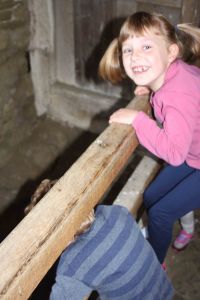
What J Likes
I am keen not to give a negative impression. Indeed, all of the issues above need not be individually or collectively ‘negative’: they are just part-and-parcel of being with J. Moreover, at many sites, she copes herself with the issues she faces and by verbalising her concerns, is increasingly able to cope with the issues.
Still, it is important to say that J is often, very, very happy visiting archaeological heritage sites, as long as she has time and space to engage in her own terms and at her own pace. She wants to roam and that is how she learns. She likes direction and can be fascinated in small details at times – to use the example again, she spent ages watching a swallow visit her nest of babies at Stokesay Castle whilst hordes of visitors wandered through showing disinterest. Other times, she cannot wait to move away from displays. She needs to be free to ignore staff and exhibits if they don’t interest her and move to what takes her fancy. This often challenges modes of expectation for behaviour from staff and other visitors, but that is just tough. She does love material culture, architecture and landscape. She just loves gravestones, church monuments, pulpits, pews (especially the boxed variety), monastic and castle ruins (climbing up them), earthworks and (increasingly but not so much) hillforts and barrows. In museums, she prefers skeletons. In short, she loves being out, about and free to roam. She also requires just a tiny bit of patience and understanding from other visitors and staff if she decides to meltdown or behave in a fashion that differs from the ‘norm’ in their eyes.
Very rarely does J’s behaviour now lead to the cancellation or foreshortening of my visits to heritage sites, monuments and landscapes, but equally I am never lower my guard in attempting to manage and alleviate her anxieties and requirements. Like any child, Jemimah can exhibit bad behaviour and while I never apologise to anyone on her behalf for her just being herself, I will reprimand her when she is behaving inappropriately and her actions are dangerous to herself or others.
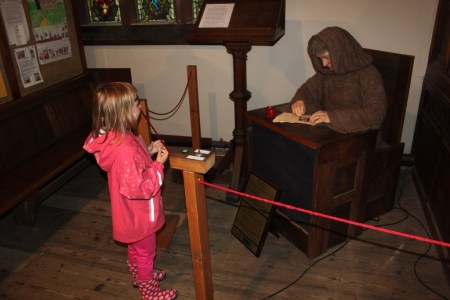
Summary
Obviously I love my daughter intensely and I am so proud of her. She has made such progress in coping with her fears and anxieties and she is increasingly vocal in communicating them to others around her. I appreciate it may seem indulgent and pretentious to talk about my own child in this public forum but the issue here is a very important one: perhaps far more than any of my other blog posts.
I think there are practical lessons I have learned about visiting and engaging with archaeological heritage as a father that I had previously never considered. J’s condition is not physical, and yet it channels and affects her engagement with the world on many levels. Most keenly, J has a fabulous memory but little conception of time. Time-lines and chronology, and the timing of our own visits, have little impact. Having said that, the sensory experience place, materials and memory are very closely linked for her, and these are all in turn closely enmeshed with her emotions as she encounters these places in relation to particular visits.
There are also clear lessons for heritage sites and ancient monuments. As well as making staff aware of children with ASD and designing interactives and displays that suit their needs, there is a need to ensure that children with this condition are not inflicted with sensory overload, unnecessary corralling into gift shops and confined spaces, and needless dialogues with people ill-equipped to converse and engage with children with her condition. Frequently, it is not Jemimah, but running the gauntlet of imposed expectations and prejudices of staff, other visitors and displays that are our collective challenge when taking her to see archaeological heritage.
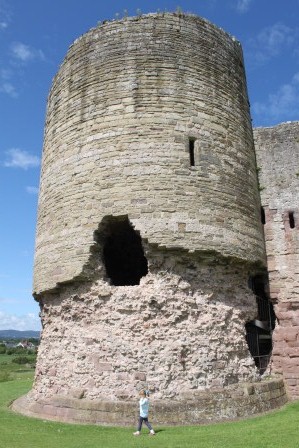
I could name and shame a few negative heritage experiences. However, I want to finish with a positive ‘shout out’. There have been many, many positive visitor experiences with Jemimah, but I want to note the great positive engagement by many Cadw staff with Jemimah, most notably at Rhuddlan Castle. Well done Rhuddlan: you have accessible toilets (if no paper towels), friendly staff and a clutter-free fun site to run around with ace staircases and ruined stone walls.
Resources

This is great Howard (and obviously v familiar)
Thank you for writing it x
This was a fantastic post Howard.
I have worked at several different museums on the front line, and I can see myself in some of your discussions of the staff. This is a good thing though, because I would hope that I am always learning and improving my interactions with the public. I try not to force interactions with children who clearly aren’t interested, but I do get down and ask questions of kids who are doing their own thing. Often, the child slowly comes out of their shell, getting over their shyness and engages enthusiastically with me and the material at hand, but sometimes they ignore me and move on – as they should.
I’m now reassessing this and trying to figure out how I could/should change my approach to keep the needs of ASD children in mind. The reality is that I can’t tell who will or will not react positively to my advances regardless of diagnoses/needs/behaviour on the best of days, and while I would never force the situation, I can see how my even asking questions to an ASD child happily engaged in their own activity could ruin it and drive them away, upsetting them.
I have very few experiences where I know now that I was interacting with people on the spectrum, and always after I had caused them some manner of distress, leading to their need to explain themselves. Makes me feel terrible, but also unsure how to proceed.
Hard questions that I am very glad you have raised for me and others.
a fascinating post. Opened my eyes, certainly.
Thank you Nancy
Fantastic post and very eye opening! A minor note but totally agree about paper towels – much more effective for getting mud off my hands when I’ve been at outdoor sites in the wheelchair than the noisy and cumbersome dryers are!
To add to your list of resources- http://archaeologistsforautism.org/ The guy in charge of that also was on our podcast- http://www.digtech-llc.com/podcast/47
Wonderful article, thanks so much for sharing! I agree that heritage sites and museums need to endeavor to facilitate learning experiences for all visitors and continue to increase accessibility!
Thanks Jamie! We have a lot of great experiences and meet lots of great staff and many supportive fellow-visitors. Still, I agree completely with your sentiment.
Hello Howard – I’m not sure if you’ll remember me – we did our Ph.Ds at Reading at more or less the same time, and I think we overlapped at Cardiff, too? A friend pointed me in the direction of this post, as our family faces many similar challenges, and I thank you for having voiced it. My younger son, Joe, who’s 4, has fairly severe autism, and as someone who both wants/ needs to visit museums and heritage sites frequently, and who also volunteers at museums whenever possible, I also wonder how these settings can incorporate mechanisms and accommodations for visitors with autism. Clearly there can never be a one-size-fits-all solution, because autism manifests in such diverse ways, but a more enlightened understanding of autism – particularly of sensory issues – at heritage sites would certainly be a good thing!
Reblogged this on Suze.se.
She understands far more than you give her credit for, she just understands it differently. That’s extremely important. Don’t ever assume she’s retarded- which is subtle here, but I know you partially think it by what you write and how you write, about her.
I won’t bother you or your blog anymore, but I do have one more thing to say in addition to my other comments. Your daughter is autistic. If you honestly think that you can focus ANY of your attention on anyone but her, you’re incredibly mistaken. I get that you have other responsibilities, but she’s DISABLED. You need to either pay more attention or find someone who will watch after her when you’re going places. The fact she was crying because you left her behind is HUGE. It doesn’t matter if you think nothing happened, or if ” very little” has to happen to upset her… It’s her brain. She’s a scared little kid. As an adult on the spectrum, this borders on abuse… but it’s square in the middle of neglect. I can’t even be left alone and my IQ is 236!!
I doubt you’ll listen to me, though. Very few neurotypical adults will bother to check their personal viewpoint with the VERY DIFFERENT YET VALID AND REAL view of us autistics, whatever our age. Honestly, your posts are so upsetting to me and full of ableist language that I can’t and will not respond to comments. Most will be condescending anyway, as you lot only pretend to believe we’re intelligent and self-aware, no matter how we actually are.
Loving your kid is great, but it’s only a start. We autistics are unintentionally abused and neglected by our loving family EVERY DAY.